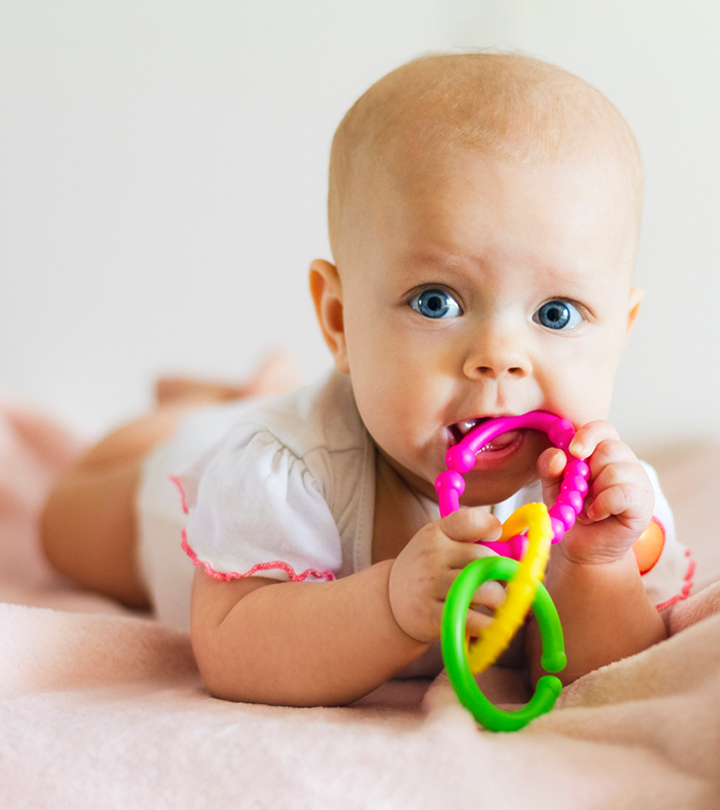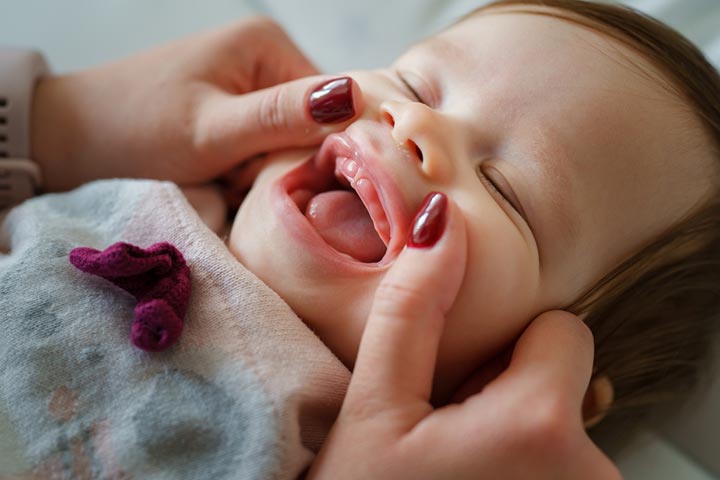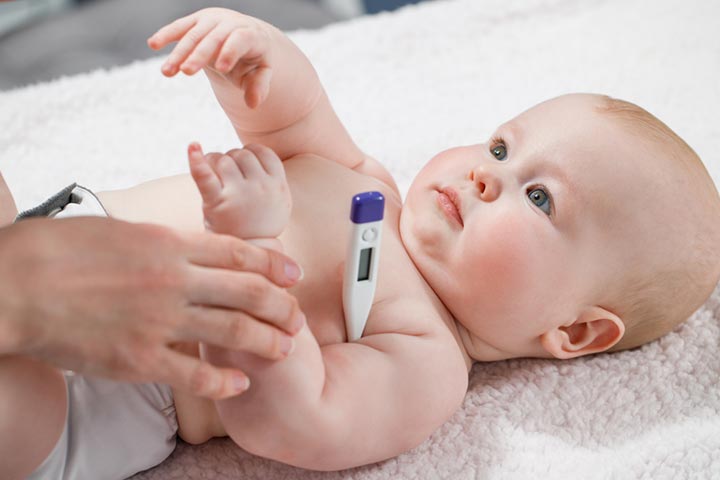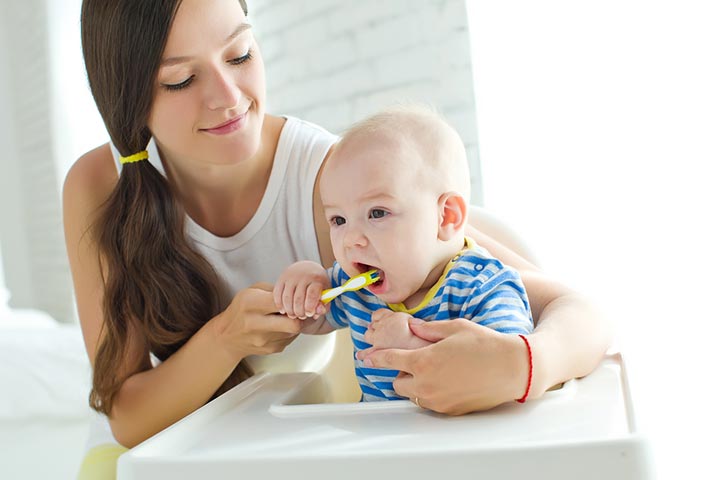Most babies develop their first teeth between four and seven months, but some may develop teeth as early as three months. Three-month-old teething is also called early eruption and is a rare condition. The early eruption’s exact cause and risk factors have not been identified, yet it is usually believed not to cause any concern.
The teeth that erupt at three months are not natal or neonatal but the primary ones that have developed earlier than usual. Stanford Children’s Health states that while teething symptoms, such as drooling and mouthing, may begin at three months, tooth eruption in most babies generally occurs later.
Read the post about the signs, effects, and management of three-month-old teething.
Signs Of Teething In Three-Month-Old Babies
Is your 3-month-old teething? The following signs may indicate teething in a three-month-old (1).
- Excessive drooling
- Putting fingers and objects in the mouth
- Swollen gums
- Irritability and crying spells
- Pain on suckling (2)
- Loss of appetite
- Sleep deprivation
Effects Of Early Teething On The Mother’s And The Baby’s Health
Early teething does not have any remarkable effects. The effects of teething are similar at all ages, such as those mentioned below.
1. Impact on the mother
- The baby might chew or bite on the mother’s nipples to soothe their irritated gums.
- Avoid screaming or getting startled as they might find it funny. Instead, say “No biting” in a strict and firm tone. They will gradually get the message.
- If the baby continues to bite, you may consider pumping and feeding breastmilk in a bottle or using nipple shields.
2. Impact on the baby
- The baby might be irritable, cranky, and fussy.
- They may have sore gums and irritation, leading to reduced appetite, increasing the risk of poor weight gain.
- The baby may rub cheeks or pull ears often due to gum irritation.
- The baby may drool more than usual, and the excess drool could cause drool rash.
A mother and a blogger shares her experience about her son Mason’s teething when he was three months old. She writes, “I think my little guy may be teething. I did a little research and it seems that babies can start teething at 3 months. He’s drooling constantly and sucking on anything he can get in his mouth. I know babies like to suck on things anyway, but I tend to think it just might be teething (i).”
It is important to note that teething does not primarily cause cold, rash, diarrhea, or fever. If any of these symptoms coincide with teething, do not consider them related and take the baby to your pediatrician.
Tips On Easing A Teething Infant’s Discomfort
The following tips may help soothe a teething baby’s gums safely (1).
- Try giving them chilled teething rings, chilled or frozen vegetables or clean, cold teething toys to nibble on. Three-month-olds might not be able to grasp them well. Therefore, you may hold them for the baby. Avoid fluid filled teething rings as the liquid may spill out and cause toxicity.
- You can get teething mittens for your baby. The three-month-old may chew on teething mittens since they cannot hold teethers properly.
- You may also consider giving them cold washcloths to chew on.
- Use your clean index finger to massage the sore gums.
- You may give your baby an orthodontic pacifier that meets safety guidelines as it will help relieve toothache and not hamper the normal growth of jaws, oral muscles, and teeth (3).
Parents and caregivers use different remedies to relieve teething pain symptoms in babies and toddlers. The graph below shows that most parents use safe methods, such as toys, rings, and medications, to alleviate teething pain. However, some parents resort to unsafe methods like amber teething necklaces and topical anesthetics to relieve teething pain in babies and toddlers.
Safe and unsafe teething remedies reported by caregivers
Source: Use of Unsafe Teething Remedies: A Survey; Journal of the Canadian Dental Association
The US Food and Drug Administration (FDA)warns against the use of topical teething gels for babies as these products can be harmful. In rare cases, if the baby is in extreme teething pain, the doctor may prescribe baby-safe painkillers such as acetaminophen (4). Certain over-the-counter painkillers such as ibuprofen are not recommended for babies below six months. Hence, only give medicines prescribed by your pediatrician.
How To Take Care Of The New Teeth?
The American Dental Association suggests the following measures for oral care in babies (5).
- Clean the baby’s mouth using a clean washcloth even before the teeth begin to erupt.
- An early dental visit to the pediatric dentist must be done after the first tooth erupts and before the first birthday.
- As soon as teeth erupt, you must begin brushing your child’s teeth.
- Avoid giving pacifiers dipped in sweet solutions.
- Avoid bottle-feeding at night.
Caution: Do not give the baby certain risky soothing toys such as teething necklaces, as they can easily break off and the baby may choke on the beads or the necklace may get caught on something and increase the risk of strangulation.
A three-month-old teething is a rare occurrence and is termed as an early eruption. However, it is better to be alert and observant of signs, such as drooling, suckling pain, swollen gums, and increased fussiness which could indicate teething in a three-month-old. Some babies may also experience sleepless nights and poor appetite. If you notice these signs early on, you may contact your baby’s pediatrician or a pediatric dentist. Assessing your baby for early teething could help take appropriate measures to support timely oral care and soothe your teething baby.
Key Pointers
- Putting fingers or objects in the mouth, drooling, lack of appetite, sleep issues, and swollen gums can be the signs of teething in a three-month-old baby.
- Early teething is not associated with significant issues other than biting nipples while breastfeeding.
- Orthodontic pacifiers, chilled teething toys, clean washcloths, or massage can help to reduce teething pain in babies.
Learn the signs of teething in your baby and discover practical ways to provide relief in this informative video for new parents. Help your little one through the teething process with ease!















